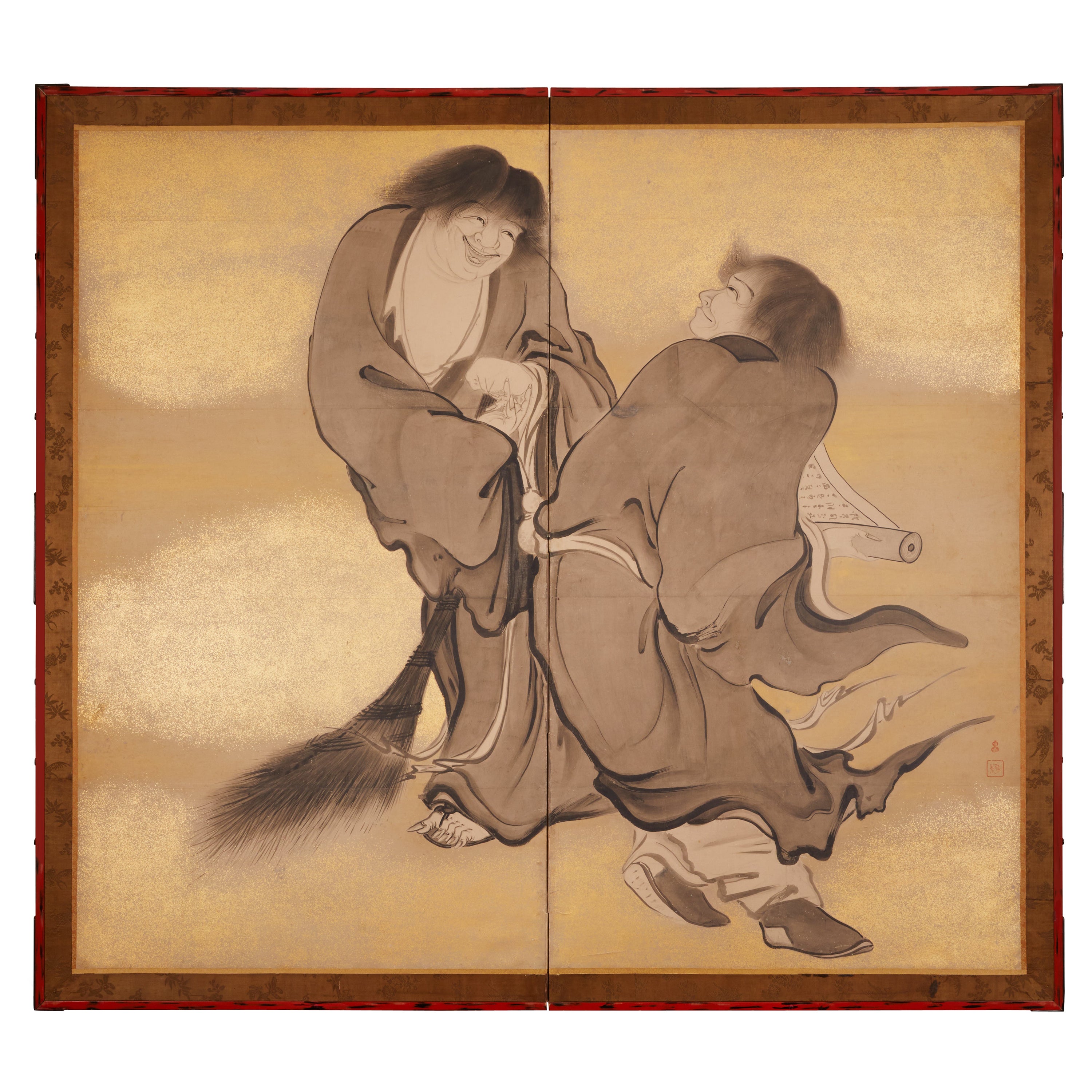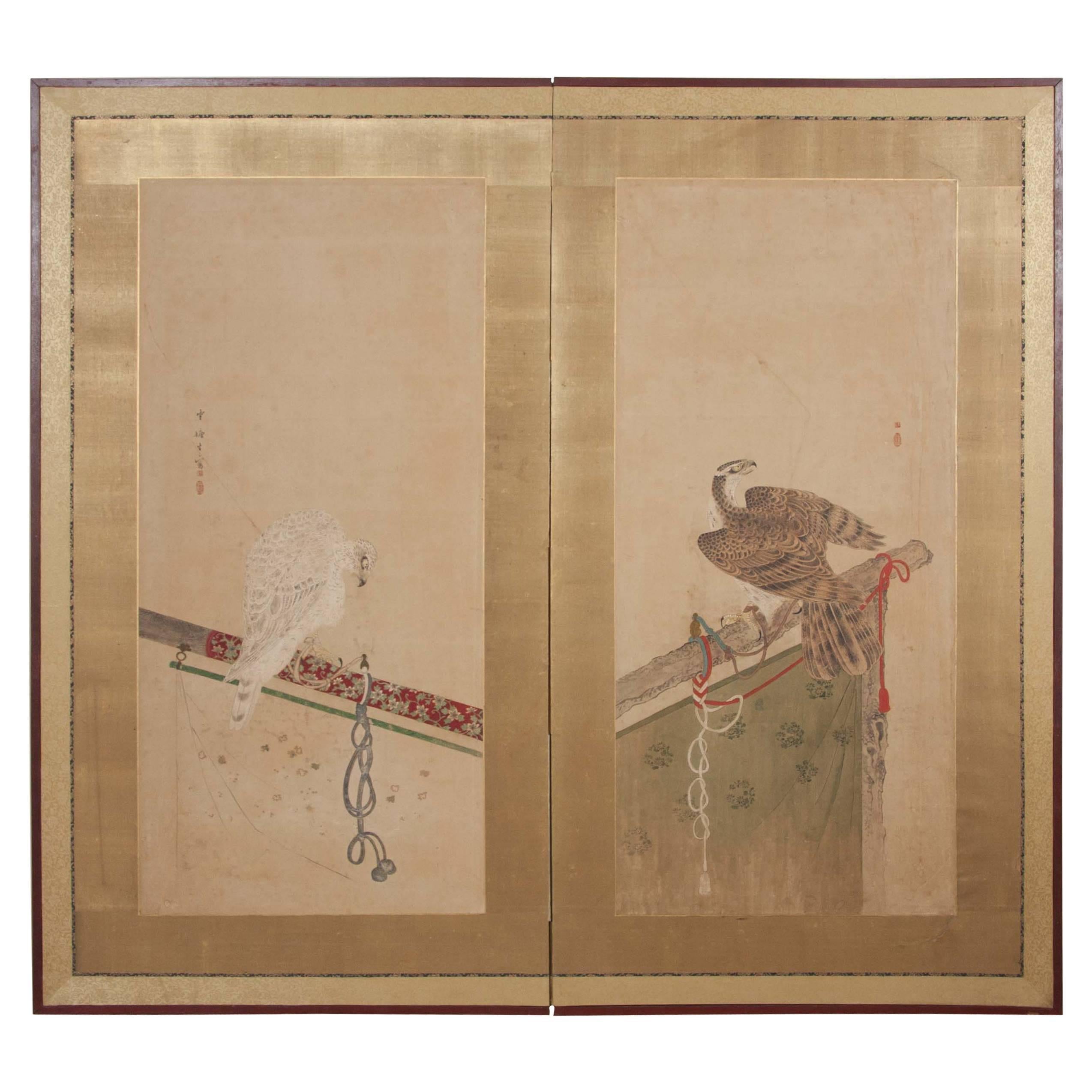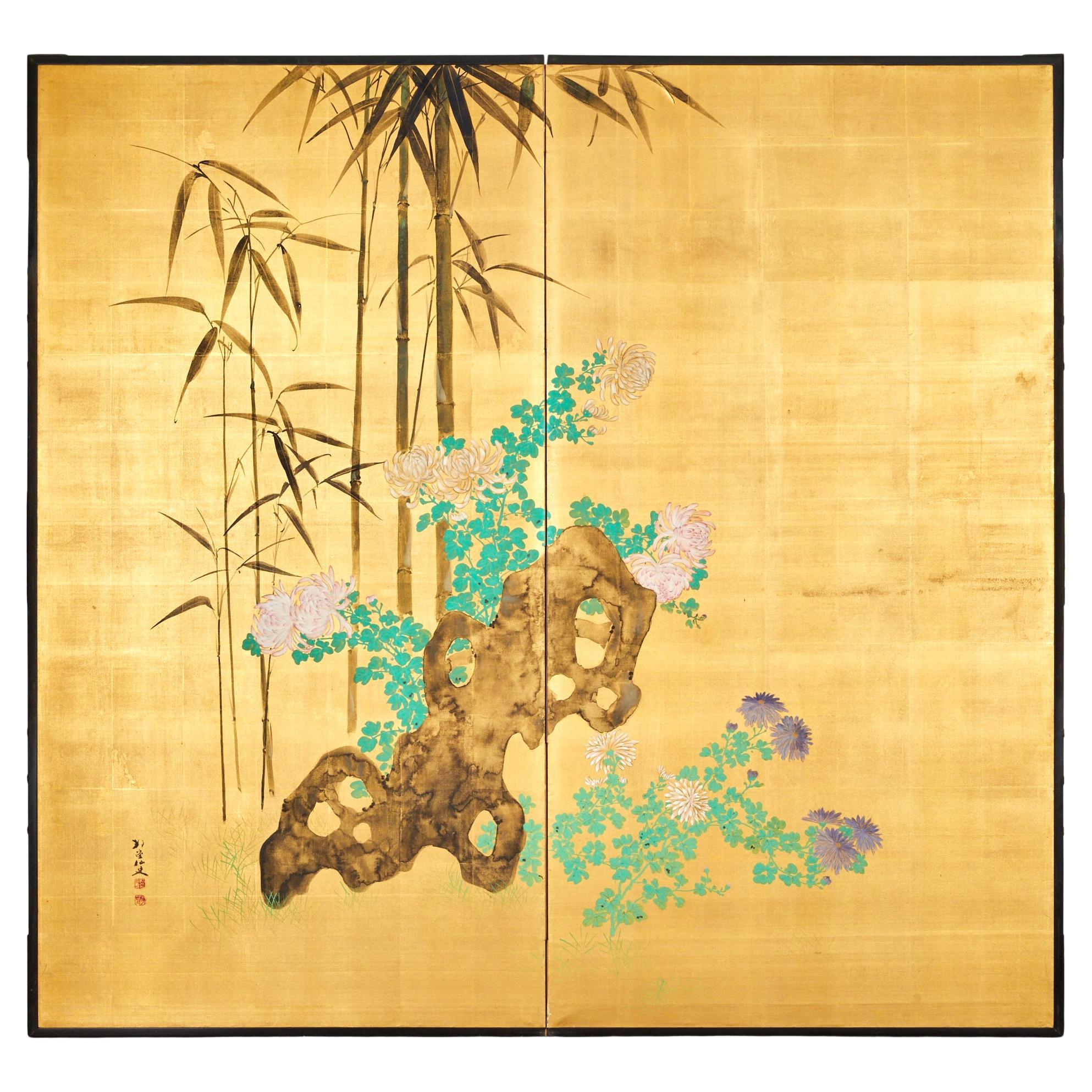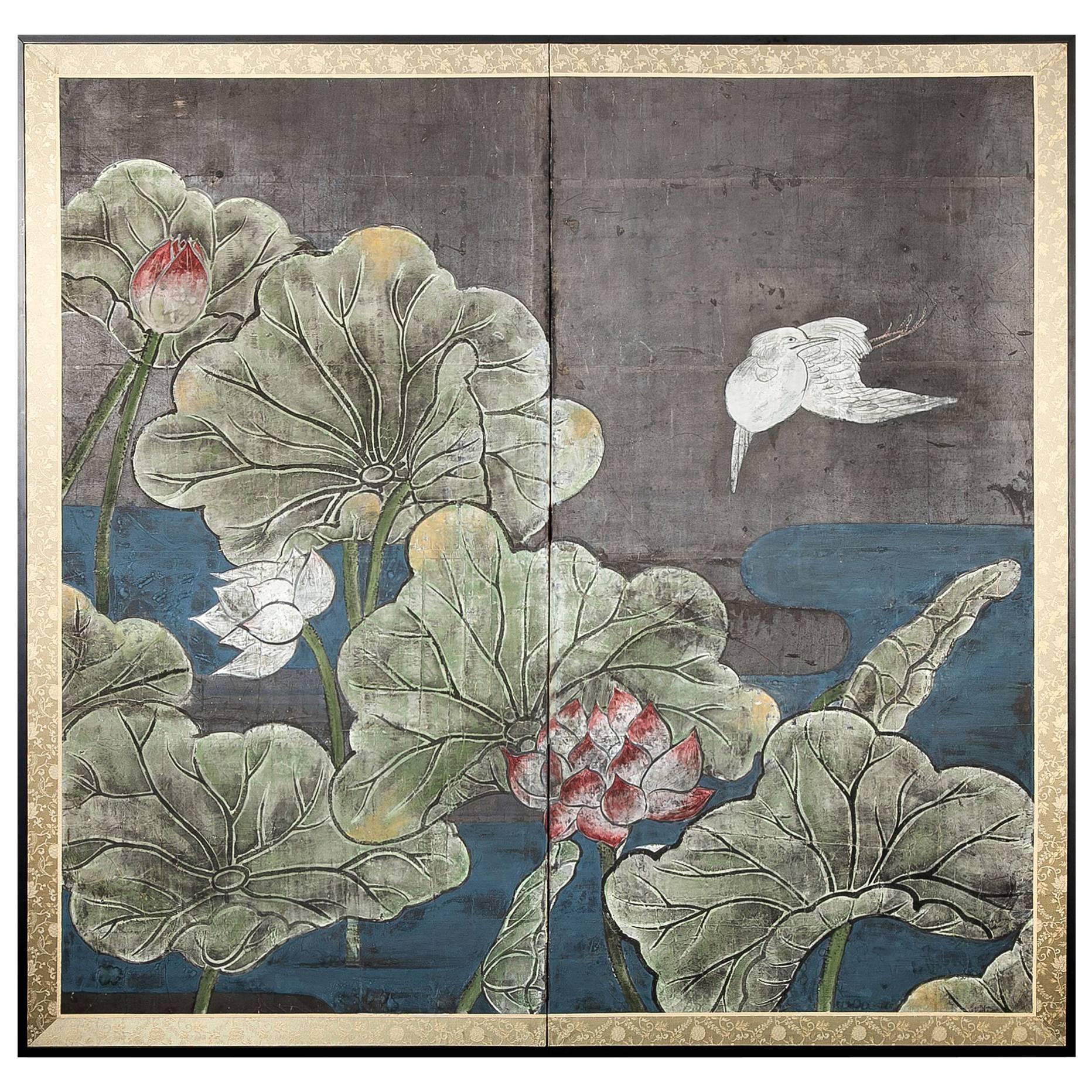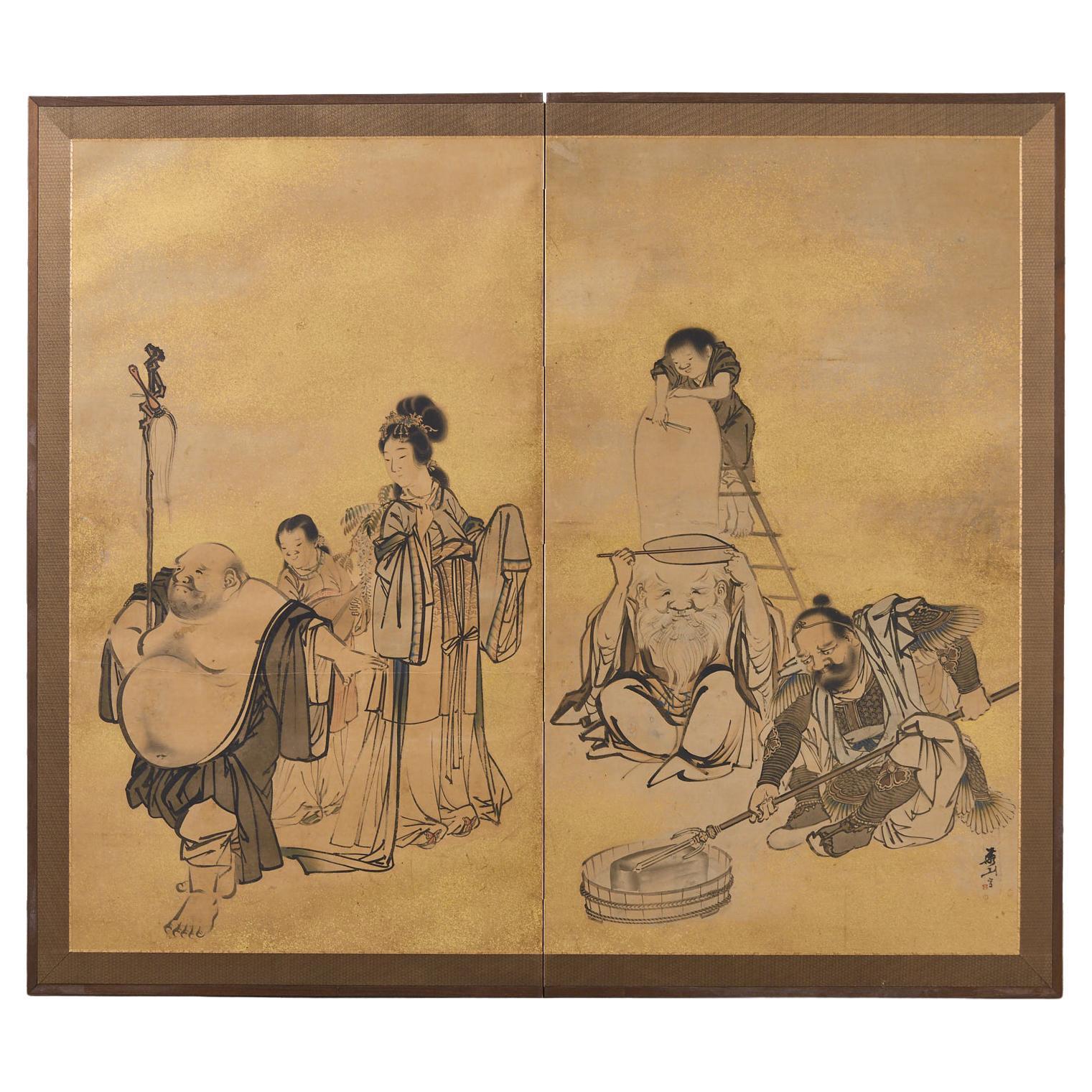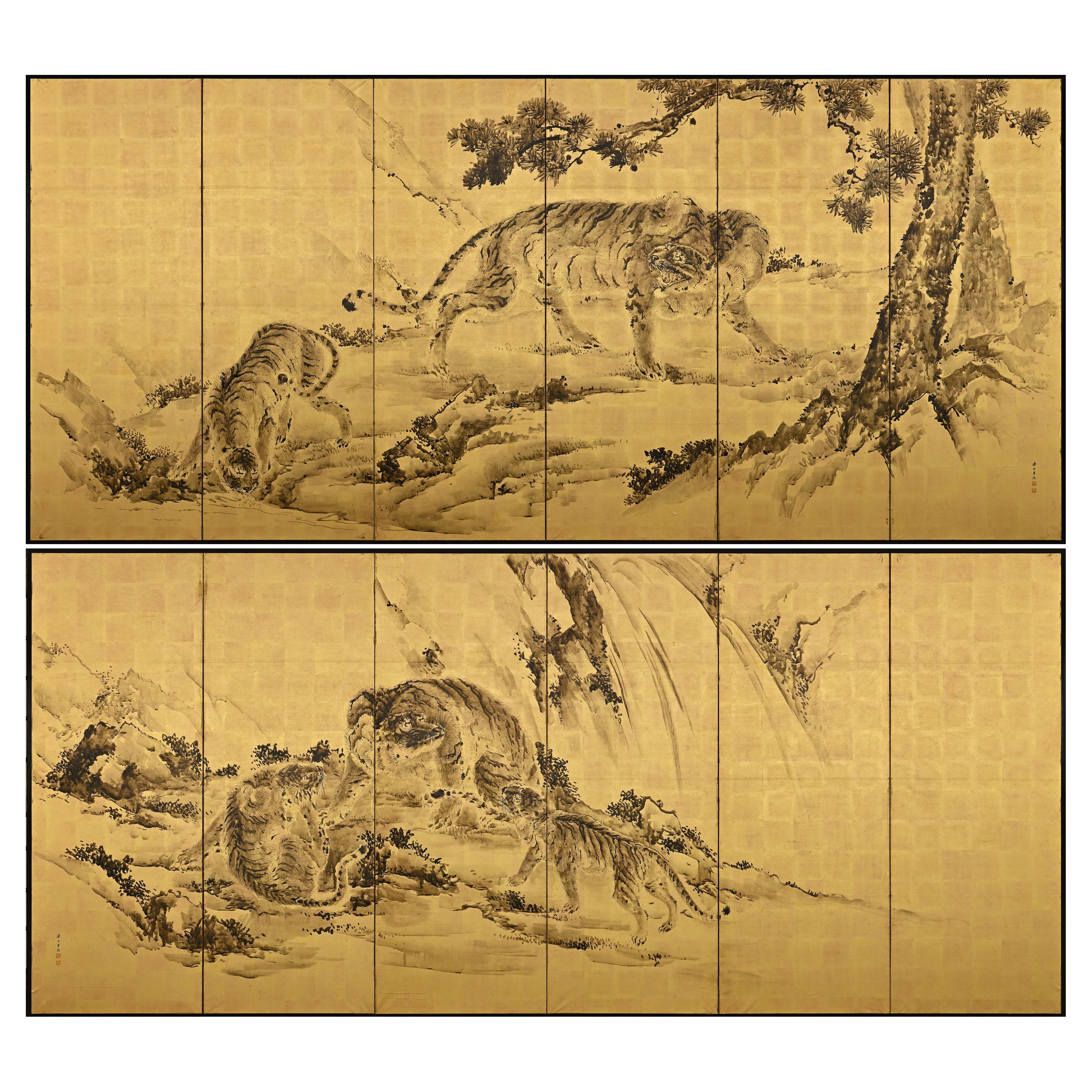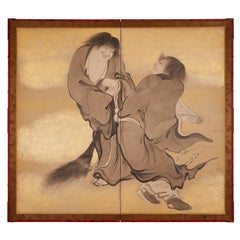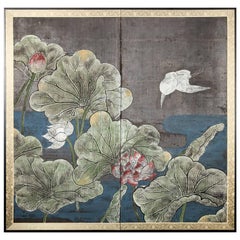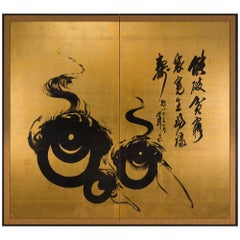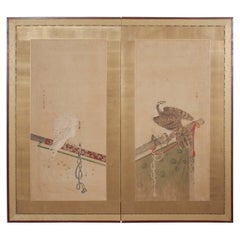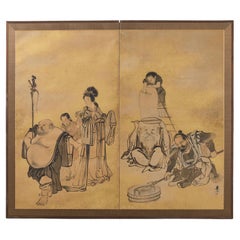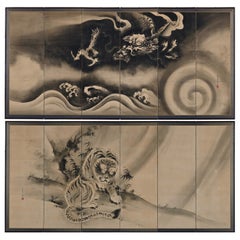Items Similar to Japanese Two Panel Screen: White Elephant and a Beauty
Want more images or videos?
Request additional images or videos from the seller
1 of 9
Japanese Two Panel Screen: White Elephant and a Beauty
$37,375
£28,535.64
€32,972.68
CA$52,467.42
A$58,480.41
CHF 30,682.67
MX$714,141.17
NOK 388,509.26
SEK 367,200.34
DKK 246,089.51
About the Item
This screen is very likely inspired by the Noh play, "Eguchi", in which the courtesan Eguchi transforms into the Buddhist deity, Fugen, who is the patron of women and is often seen on an elephant. Mineral pigments painted on gilt hand made mulberry paper and with a silk brocade border. Signature reads: Takekiyo hitsu.
- Dimensions:Height: 68.5 in (173.99 cm)Width: 66.25 in (168.28 cm)Depth: 0.75 in (1.91 cm)
- Materials and Techniques:
- Place of Origin:
- Period:
- Date of Manufacture:circa 1850
- Condition:Condition report upon request.
- Seller Location:Hudson, NY
- Reference Number:Seller: S10931stDibs: LU855134797382
About the Seller
5.0
Recognized Seller
These prestigious sellers are industry leaders and represent the highest echelon for item quality and design.
Established in 1971
1stDibs seller since 2008
166 sales on 1stDibs
Typical response time: 10 hours
Associations
The Art and Antique Dealers League of AmericaAntiques Associations Members
- ShippingRetrieving quote...Shipping from: Hudson, NY
- Return Policy
Authenticity Guarantee
In the unlikely event there’s an issue with an item’s authenticity, contact us within 1 year for a full refund. DetailsMoney-Back Guarantee
If your item is not as described, is damaged in transit, or does not arrive, contact us within 7 days for a full refund. Details24-Hour Cancellation
You have a 24-hour grace period in which to reconsider your purchase, with no questions asked.Vetted Professional Sellers
Our world-class sellers must adhere to strict standards for service and quality, maintaining the integrity of our listings.Price-Match Guarantee
If you find that a seller listed the same item for a lower price elsewhere, we’ll match it.Trusted Global Delivery
Our best-in-class carrier network provides specialized shipping options worldwide, including custom delivery.More From This Seller
View AllJapanese Two Panel Screen: Kanzan and Jittoku
Located in Hudson, NY
Prominent figures in Japanese folklore. The Chinese poet-sage Kanzan is depicted with his scroll, and the Daoist sage Jittoku with his broom. Painting bears two seals of Nakanuma Sho...
Category
Antique Late 19th Century Japanese Paintings and Screens
Materials
Gold
Japanese Two Panel Screen: Garden Scene
Located in Hudson, NY
Bamboo, chrysanthemums and garden stone in mineral pigments on a gold silk ground. Black lacquer trim with well patinaed bronze hardware. Signature and seals read: Seido Senshi
Category
Early 20th Century Japanese Paintings and Screens
Materials
Bronze
Japanese Two Panel Screen, Lotus and Heron
Located in Hudson, NY
Japanese two panel screen, lotus and heron
Colored mineral pigments on silver leaf on handmade mulberry paper.
Category
Antique Late 19th Century Japanese Paintings and Screens
Japanese Two-Panel Screen Three Jewels of Buddhism
Located in Hudson, NY
Japanese two-panel screen: Three Jewels of Buddhism. Meiji period (1868-1912) painting. The three jewels of Buddhism are the teacher, the lesson, and the ...
Category
Antique Late 19th Century Japanese Meiji Paintings and Screens
Materials
Silk, Wood, Paper
Japanese Two Panel Screen: Dancing Zodiac Animals at New Years Festival
Located in Hudson, NY
Animals of the Japanese zodiac dancing in colorful costumes celebrating the New Year.
Category
Antique Early 19th Century Japanese Paintings and Screens
Materials
Brocade, Silk, Paper
Japanese Four Panel Screen: Two Tigers
Located in Hudson, NY
Two tigers exchanging amorous glances. Kano School painting.
Category
Antique 18th Century Japanese Paintings and Screens
Materials
Paper
You May Also Like
Japanese Edo Period Two-Panel Screen
Located in Stamford, CT
A Japanese Edo Period two panel folding screen with white and brown hawks of ink and color on paper.
Category
Antique Mid-19th Century Japanese Edo Paintings and Screens
Materials
Paper
Japanese Edo Two Panel Screen Deities by Yokoyama Kazan
Located in Rio Vista, CA
Whimsical Japanese late Edo period two-panel screen circa 1800 by Yokoyama Kazan (Japanese 1784-1837). The screen depicts four of the seven Gods or deities ...
Category
Antique 19th Century Japanese Edo Paintings and Screens
Materials
Brass, Gold Leaf
Japanese Screen Pair, Tigers by Kishi Renzan, Late Edo Period
Located in Kyoto, JP
Kishi Renzan (1804-1859)
Tigers
Pair of six-panel Japanese screens.
Ink and gold-leaf on paper.
In this monochromatic pair of six-fold Japanese screens painted on gold-leaf, Kishi Renzan has created a breathtaking composition of a family of tigers. The screens are filled with a sense of drama which is conveyed by both the subject matter and the wet, expressive brushwork. The running mountain stream and the towering waterfall allude to refreshment during the summer months and we feel the tiger families familiarity and security within their environment. Renzan’s master, Kishi Ganku...
Category
Antique Mid-19th Century Asian Edo Paintings and Screens
Materials
Gold Leaf
19th Century Japanese Screen Pair. Tiger & Dragon by Tani Bunchu.
Located in Kyoto, JP
Tani Bunchu (1823-1876)
Tiger and Dragon
A pair of six-panel Japanese screens. Ink on paper.
In this grand pair of Japanese Ryuko-zu screens the tiger crouches low to the ground, ...
Category
Antique Mid-19th Century Japanese Edo Paintings and Screens
Materials
Wood, Paper
17th Century Japanese Screen Pair. Tiger & Dragon by Kaiho Yusetsu
Located in Kyoto, JP
Kaiho Yusetsu (1598-1677)
Tiger and Dragon
Early Edo Period, Circa 1650
A Pair of Six-fold Japanese Screens. Ink and slight color on paper.
Dimensions:
Each screen: H. 171 cm x W. 380 cm (67.5’’ x 149.5’’)
In this pair of early Edo period Japanese screens a group of tigers prowl in a bamboo grove whipped with fierce wind, while a dragon claws through clouds and mist. The dragon embodies elemental qualities - looming out of the mist, the coils of its body disappearing in the clouds. The dragon is calling for rain, symbolizing spring which is considered the fountain of life. On the other side, the tigers calls for the wind, symbolizing autumn which is considered the end of life. Tigers were familiar motifs within Japanese art from ancient times though the animals were imaginary to the people in the 17th century. While dragons and tigers are usually associated as sacred and ferocious, in this painting, both animals have rather amusing expressions. The tigers appear to glare at the dragon with cat-like eyes, and the look on the swirling dragon’s face appears almost affectionate - lending a playful flair to an otherwise magnificent theme.
The tiger and dragon are cosmological symbols of the balancing forces in the world. Screens such as this were originally meant to express the fluctuating nature of the world. For Japanese in the early Edo period, they likely suggested the powers of the cosmos. In Japan the tiger and dragon motif was originally absorbed into the circles of Zen monasteries before spreading into the secular world. The theme especially appealed to the military classes with the Kano school, the official painters to the Shogun and the samurai, being the leading contributors. The painter of this pair of screens, Kaiho Yusetsu (1598-1677), was closely patronized by the third Shogun Tokugawa Iemitsu. In his later years he worked with Kano school artists...
Category
Antique Mid-17th Century Japanese Edo Paintings and Screens
Materials
Silk, Wood, Paper
Antique 19th Century Japanese Two-Panel Screen ‘Byobu’, Kano School, Edo Period
Located in London, GB
Japanese Kano School Edo period two-panel screen depicting flowering prunus and bamboo on a rock formation, with colorful birds next to a body of water. ...
Category
Antique Mid-19th Century Japanese Edo Paintings and Screens
Materials
Gold Leaf
More Ways To Browse
Japanese Beauties
Asian Elephants
Japanese Silk Brocade
Japanese Elephant
Mineral Pigments On Silk
Japanese Buddhist Screen
Japanese Painting Women
Japanese Gilt Wood
Asian Bird Paintings
Gilt Lacquer Panel
Four Panel Asian Art
Japanese Silk Brocade
Pair Of Japanese Paintings
Gold Cranes
Chinese Scroll Paintings
Chinese Lacquered Screen
Scroll Painting Silk
Japanese Antique Gold Screen
